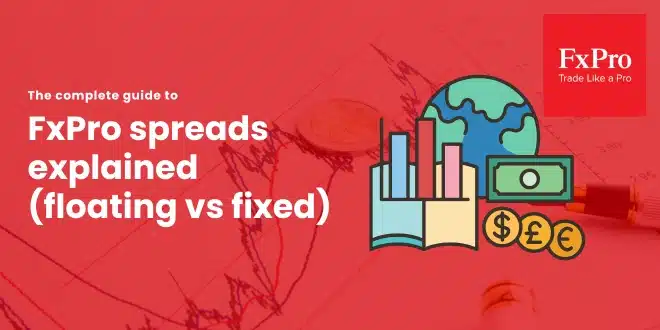Spreads are one of those quiet trading costs that sneak up on you — especially when you’re just starting out. If you’ve ever opened a trade and noticed you’re instantly in the red, that’s the spread at work.
In this guide, we’ll break down how FxPro handles spreads — specifically the difference between floating and fixed spreads — so you can make smarter decisions, save money, and reduce unexpected outcomes. You’ll get real examples, platform tips, and a simple way to figure out which one fits your style best.
What exactly is a spread?
A spread is the difference between the price you can buy an asset for (ask) and the price you can sell it for (bid). It’s how brokers like FxPro make money on commission-free accounts — and it’s a cost you pay on every trade.
Simple example: If EUR/USD has a buy price of 1.1002 and a sell price of 1.1000, the spread is 0.0002 — or 2 pips.
You need price to move at least 2 pips in your favor just to break even.
Floating vs Fixed Spreads — what’s the difference?
Let’s simplify it.
- Floating spreads change with the market. They’re tighter when markets are calm and widen during volatility.
- Fixed spreads stay the same no matter what’s going on. They don’t change — even during big news events.
Here’s a practical breakdown:
Floating Spreads:
- Move with market conditions
- Usually tighter during high liquidity (like London or NY open)
- Can spike during news or overnight hours
- Found on most FxPro accounts: MT4, MT5, cTrader, Edge
Fixed Spreads:
- Stay constant
- Offer more price certainty
- Available on MT4 only with select instruments
- Slightly wider to offset volatility risk
- When floating spreads work best
Floating spreads can be incredibly low if you trade during the right time. For example, traders using FxPro’s cTrader or Raw+ accounts report spreads on EUR/USD dropping to 0.1 or 0.3 pips during active hours.
Ideal for:
- Day traders during high volume times (8am–4pm GMT)
- Scalpers who need the tightest spread possible
- Traders who avoid holding through big news
But be careful. Floating spreads widen fast during news releases, low volume hours, or Sunday market open. That can lead to slippage or early stop-outs.
When fixed spreads make more sense
If you’re trading during volatile conditions or want peace of mind about entry and exit costs, fixed spreads may be the better choice.
You might pay more per trade (e.g., 1.6 pips on EUR/USD instead of 0.4), but it’s a cost you can plan for — and it won’t jump mid-trade.
Ideal for:
- Trading around events like CPI or NFP
- New traders who want cost predictability
- Holding positions overnight or through weekend gaps
Just note: fixed spreads are only available on MT4 with limited assets, so you’ll have fewer options.
How much does spread really cost you?
Let’s say you trade 1 standard lot of EUR/USD:
- Fixed spread = 1.6 pips
- Floating spread (during London open) = 0.4 pips. That’s a 1.2 pip difference — or $12 more per trade.
Now multiply by 20 trades a month. That’s $240/month in extra spread cost just for choosing fixed over floating.
So the tradeoff is clear: floating spreads are cheaper if you’re trading at the right time. Fixed spreads are more stable but come at a price.
Spreads and slippage — what you need to know
Floating spreads can affect how your Stop Loss and Take Profit behave.
Picture this:
- You set a Stop Loss 20 pips away
- News hits and the spread widens to 5 pips
- Your SL is now triggered earlier — or worse, at a worse price than planned
This isn’t a bug. It’s normal behavior when spreads shift. That’s why many traders widen their SL buffer or avoid tight stops during volatile times.
How spreads differ by FxPro platform
Not all platforms are equal when it comes to spreads.
MT4/MT5:
- Offers both floating and fixed
- Best for traditional FX and algorithmic strategies
- Fixed spreads only on MT4
cTrader:
- Known for ultra-tight floating spreads
- Raw+ accounts offer spreads from 0.0 with commissions
- Preferred by scalpers and pros
FxPro Edge:
- CFD-focused web platform
- Floating spreads only
- Good for casual and multi-asset traders
Match your trading style to the right spread type
Use this simple guide to decide what fits your needs:
- Scalper: Go with cTrader + floating spreads during high liquidity hours. You’ll get tight pricing and fast execution.
- News trader: Stick with MT4 + fixed spreads. You’ll avoid spread spikes that can wreck a good setup.
- Swing trader: Use floating spreads, but avoid holding through events or weekend gaps.
- Beginner: Start with fixed spreads so you can focus on learning without worrying about price jumps.
Practice challenge: Which spread is better for you?
Try this 3-day experiment in FxPro’s demo account:
Day 1: Trade EUR/USD with a floating spread on cTrader during the London session. Track spread size before and after the trade.
Day 2: Trade the same pair on MT4 with a fixed spread — at the same time of day. Record your entry cost and execution feel.
Day 3: Try trading 10 minutes before a scheduled news release with both types. Watch how the spreads behave.
Afterward, compare:
- Which gave you more control?
- Which felt riskier?
- Which cost more?
Final thoughts
Spreads may be invisible — but they’re not small. Every pip you save adds up. Every spike you avoid protects your balance. Whether you go fixed or floating, the goal is the same: smarter trades, tighter costs, and better decisions.
Start small. Stay aware. And make every trade count.
FAQs
1. What’s the cheapest spread type on FxPro? Floating spreads — especially on cTrader or Raw+ accounts — tend to be the lowest during peak market hours.
2. Can spreads change after I place a trade? Yes, with floating spreads. They respond to market conditions. Fixed spreads do not change.
3. Which platform offers the tightest spreads? Most traders report the best spreads on FxPro’s cTrader, especially during high liquidity times.
4. What’s the downside of fixed spreads? You may pay more per trade — and they’re not available on all assets.
5. Do fixed spreads protect me from slippage? No, slippage can still happen, but the cost per trade (spread) stays stable.
6. Are spreads worse at night? Often yes — floating spreads tend to widen during rollover hours or illiquid times.
7. Should beginners start with fixed or floating? Fixed spreads offer predictability. Floating spreads are cheaper if you trade during calm, active hours. Test both in demo.
8. How do I avoid spread spikes? Don’t trade during major news events or low liquidity hours. Set alerts and widen SL buffers if you must trade then.
9. Can I change spread types mid-account? No, but you can open another FxPro account type or use a different platform to switch.
10. What if I’m still unsure which is better? Use demo mode. Trade both spread types and track the results. Experience will make it clear.


